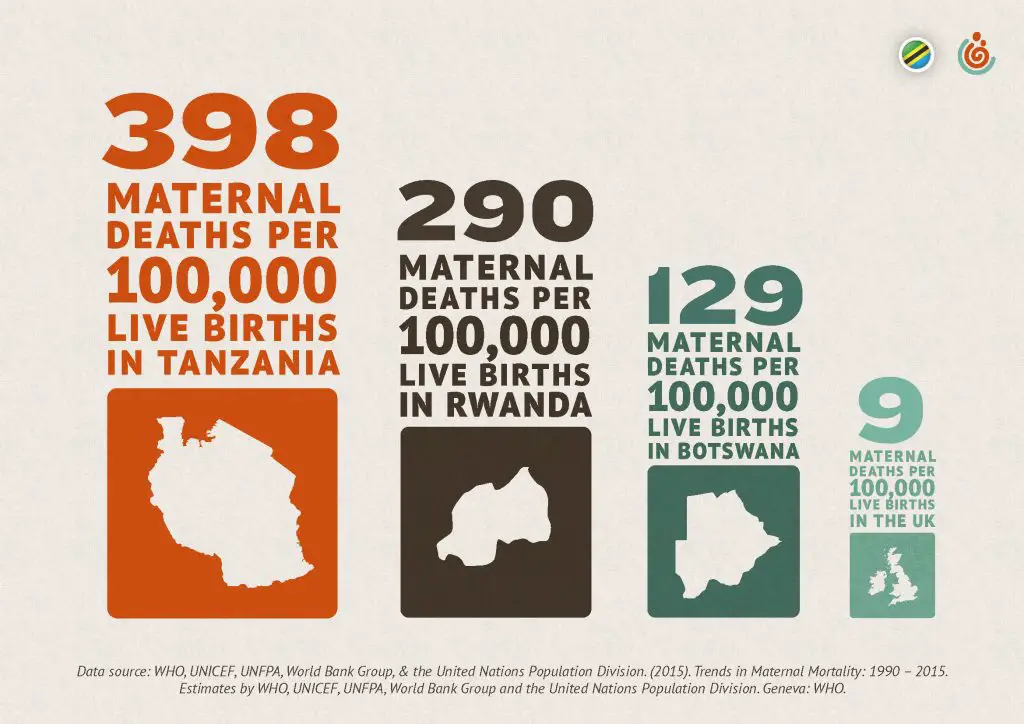A region in Tanzania that focused on improving obstetric care services potentially averted an estimated 2,100 maternal deaths between 2011–2018, according to data released by the CDC Foundation. The data include the results of treatment provided by all emergency obstetric care facilities in the Kigoma Region, where maternal deaths were among the highest in Tanzania, a nation which has the sixth-highest number of maternal deaths in the world.
The Maternal and Reproductive Health in Tanzania Project began in 2006 as a collaborative effort with the Tanzanian government to prevent maternal deaths and increase access to emergency obstetric care and other reproductive health services by upgrading health facilities and training health workers. The CDC Foundation has supported the U.S. Centers for Disease Control and Prevention (CDC) in monitoring and evaluating the program since 2010.
The new data released by the CDC Foundation provide new information related to maternal mortality and emergency obstetric care. As part of the 2,100 maternal deaths potentially averted through services provided by emergency obstetric and neonatal care facilities, 1,450 maternal deaths were averted through services provided in project-supported hospitals and health centers. Bloomberg Philanthropies and Fondation H&B Agerup provided financial support for this effort, and program implementation partners include Thamini Uhai, Vital Strategies and EngenderHealth, who worked in partnership with the Kigoma Regional Government.
Read also: Germans successfully tests drones to deliver medicine in Tanzania’s remote Island
“The CDC Foundation is proud to support the lifesaving work of CDC to reduce maternal and neonatal mortality and build healthcare monitoring capacity in Tanzania, where one woman dies nearly every hour from complications of pregnancy and childbirth,” said Judith Monroe, MD, president and chief executive officer of the CDC Foundation. “We are grateful to the Tanzanian government, Bloomberg Philanthropies and Fondation H&B Agerup for their support of these vital efforts to support mothers and infants in Tanzania.”
The CDC-led Pregnancy Outcomes Monitoring System and Health Facility Assessment study results found that the project has been successful in ensuring that more women with life-threatening complications during pregnancy and childbirth were receiving appropriate facility-based care. Additionally, the proportion of births taking place in health facilities in Kigoma Region increased from 48 percent in 2011 to 85 percent in 2018, exceeding the project’s target of reaching 75 percent by April 2019.
Importantly, the number of medical doctors working in facilities increased four-fold in 2018 compared to 2016. In 2018, the government of Tanzania allocated 369 health providers to Kigoma Region to help close the staffing gap. Also, the number of facilities providing emergency obstetric care increased. The expected number of women with direct obstetric complications receiving care improved from 43 percent in 2011 to 61 percent in 2018. This performance exceeds the project target of 60 percent for met need for emergency obstetric and neonatal care by April 2019.
Read also: India eyes the Tanzanian health sector
The comprehensive findings of the evaluation of the project were presented in a series of executive summaries that were shared with Tanzanian government officials, partners and other stakeholders this week. The presentation of these findings marks the final transition of the project to the Tanzanian government, which has committed to continue program activities.
This transition is an acknowledgement of the project team’s success in increasing capacity for maternal and neonatal care in Kigoma, and this success helps inform priorities for long-term sustainability of the health care services. Sustainability to support this transition was built into the program through mentoring and training health officers in clinical capacity and using maternal and child health data for policy and program action.
The Regional Medical Officer for Kigoma Region, Dr. Paul Chaote, said, “These evaluation data are very encouraging for the Kigoma Region because they show our joint efforts that we have invested in to improve obstetric care. They have shown areas we are on track and areas that need improvement. We are thankful to all partners who have made this possible.”
To date, the work funded by Bloomberg Philanthropies and Fondation H&B Agerup has been implemented in three regions in Tanzania (Morogoro, Pwani and Kigoma). CDC’s role has been to evaluate the efficacy of the project’s programmatic activities and their impact on health outcomes. The data can be used to prioritize actions to improve quality of care for women in health facilities and improve data for decision-making in Kigoma Region.
The CDC Foundation helps the Centers for Disease Control and Prevention (CDC) save and improve lives by unleashing the power of collaboration between CDC, philanthropies, corporations, organizations and individuals to protect the health, safety and security of America and the world. The CDC Foundation is the sole entity authorized by Congress to mobilize philanthropic partners and private-sector resources to support CDC’s critical health protection mission. Since 1995, the CDC Foundation has launched approximately 1,000 programs and raised over $800 million. The CDC Foundation managed nearly 300 CDC-led programs in the United States and in more than 130 countries last year.
